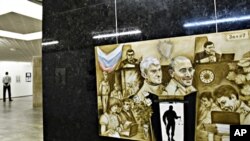Russia’s authoritarian politics may be gray and conservative. But Russia modern art scene is colorful and eccentric.
A Lenin head is offered up on a dinner table. A pig-like policeman swills a bottle of vodka. And a near-naked man sits in a transparent cube, reading a book.
Welcome to the vibrant land of Russian modern art.
Russian liberals say politics are authoritarian and stage-managed by the Kremlin. But a few blocks away, at the Central House of Artists, the motto is: "Anything goes!"
American artist John Varoli has seen Russia art flourish since moving here in the early 1990s.
"Russia is quite grey and conservative overall,” Varoli said. “There are islands of creativity, prosperity, of avant-garde."
Varoli was speaking on the sidelines of the Kandinsky Prize show, which draws big crowds every year. Here you can find a jarring variety of paintings, sculptures and installations.
London gallery owner Tim Marlow flew to Moscow to participate in the jury.
"One of the things I sense when I am here is that there are artists that have that sense of something to kick against,” said Marlow. “That authority, whether its soft power or that specter of censorship - whether it is religious or on sexual or moral grounds - that hovers here. In the West, a lot of that has dissipated. In some ways it leads to a more confrontational art."
Some paintings mock Russian Prime Minister Vladimir Putin. Others take a whack at Russia’s 20th century icon - Vladimir Lenin.
Some Russian artists draw on their nation’s rich history and culture.
Mikhail Ivanov brought his painting of Yuri Gagarin’s cosmonaut helmet, and a piece that draws on memorabilia from his Soviet childhood.
He says that Russian art tries to be very cosmopolitan. It looks to the West and has lost its own roots.
Across town, at Vinzavod, a red brick wine factory converted into a popular gallery and studio complex, painter Chtak says that he is a painter of the world - who happens to live and work in Moscow. His paintings have shown in London and are not influenced by Russian themes, but by:
Chtak said, "Language, text, letters, history of art..."
Back at the Kandinsky, German gallery owner Volker Diehl says the Moscow art scene changes so rapidly that he has to come here several times a year to keep on his toes.
"There are younger generations that are pushing very hard,” said Diehl. “And the generations are changing every three or five years. And these young people are very innovative, very creative and very much Western oriented."
One modern art show last year drew 100,000 people in one month. In a nation notorious for its rules, Muscovites like modern art - a cultural fantasy island where there are no rules.






